Types of Pins: A Quick Reference Guide for Engineers and Designers
Struggling to find the perfect pin for your project? Pins play a vital role in engineering and design, ensuring precision and stability. This guide simplifies your selection process.
Pins are essential components used in various industries for fastening, positioning, and securing parts. This comprehensive guide explores their types, applications, materials, and selection tips, providing engineers and designers with a reliable reference.
Let’s explore their classifications, types, and applications in detail.
What Are Pins and Why Are They Important?
Pins are small mechanical parts used to hold things together, keep them in place, or help align them correctly. You’ll find them in everything from machines and cars to furniture and medical tools. There are many types of pins, including dowel pins, clevis pins, and cotter pins, each designed for a specific job, such as connecting moving parts or locking components securely.
Although pins are simple in appearance, they play a big role in making products strong, safe, and easy to build or repair. Whether it’s helping two metal parts line up perfectly or letting a part swivel smoothly, pins are trusted for their reliability, precision, and strength in everyday use.
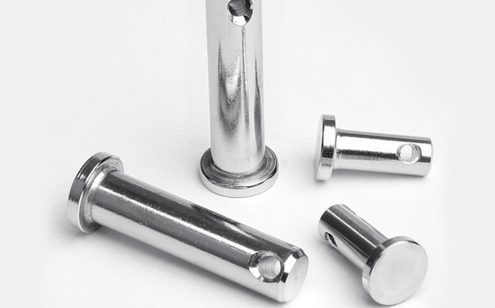
Types of Pins and Their Uses
Pins come in a wide range of designs, each tailored for specific functions across industries such as manufacturing, construction, automotive, and even fashion. Whether the goal is to align parts, secure joints, or add decorative flair, there’s a type of pin engineered for the task. Below is a breakdown of the most common pin types and how they’re used:
1. Dowel Pins
Dowel pins are solid, straight metal rods used to align or hold parts together with high precision. They fit tightly into holes drilled into two separate components, making sure they line up perfectly. These pins are commonly used in mechanical assemblies, woodworking, and tooling fixtures where accurate alignment is essential.
2. Clevis Pins
Clevis pins are cylindrical pins with a flat head on one end and a hole on the other. A cotter pin is inserted through the hole to secure it. They are mainly used to connect moving parts in machinery, such as linkages and hinges, because they allow rotation while keeping components connected.
3. Spring Pins (Tension Pins)
Spring pins are hollow, slotted pins made to compress when inserted into a hole and then expand to hold themselves in place. This design allows them to absorb vibrations and shocks, which makes them perfect for applications in vehicles, power tools, and industrial machines where movement and stress are frequent.
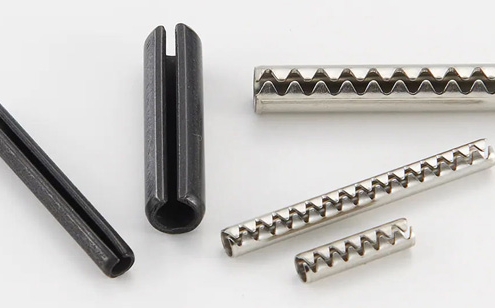
4. Lock Pins
Lock pins are fasteners that feature locking mechanisms, such as ball detents or push-button releases, to hold parts in place securely. These pins are easy to install and remove without tools, making them ideal for use in construction, transportation equipment, and adjustable machinery parts.
5. Enamel Pins
Enamel pins are decorative metal pins often filled with colorful enamel paint and covered with a clear coating. They are not used for fastening mechanical parts but for expression, branding, or decoration. You’ll find them on clothing, backpacks, hats, and in collectors’ displays.
6. Lynch Pins
Lynch pins are designed to secure items on a shaft or axle. They have a loop that locks the pin in place, preventing accidental removal. They are widely used in agriculture and construction equipment where quick assembly and disassembly of parts is needed.
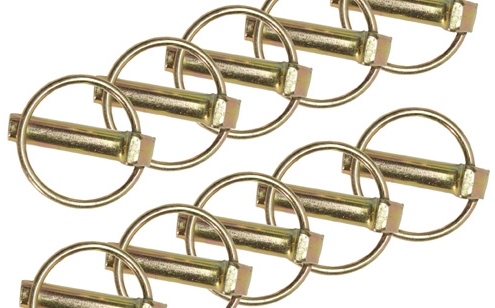
7. Taper Pins
Taper pins have a narrow end and a wider end, allowing them to fit tightly into holes by friction. As they are pushed in, they create a very snug fit, often without the need for extra fasteners. These are commonly used in mechanical systems where exact positioning and a strong hold are required.
8. Cotter Pins
Cotter pins are metal pins with two split legs that are inserted into a hole and then bent to secure them. They are often used alongside bolts and clevis pins to stop parts from sliding out. These are very common in automotive, aircraft, and industrial machinery.
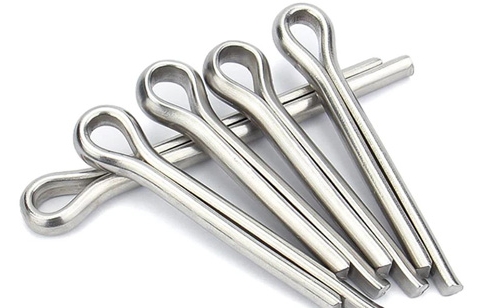
9. Machine Pins
Machine pins are precision pins used in automated systems like CNC machines, jigs, and dies. They help maintain exact alignment of components during machining or assembly. Their high level of accuracy ensures the reliability of manufacturing processes and equipment.
10. Safety Pins
Safety pins are small, spring-loaded pins with a clasp that covers the sharp point. They are mainly used for temporary fastening of fabric or attaching labels. Common in households, sewing kits, and fashion, safety pins are simple but extremely handy.
11. Construction Pins
Construction pins are large, rugged fasteners made to handle heavy loads and harsh environments. They are used to secure scaffolding, hold structural parts in place, or connect heavy machinery components. Their strength and durability make them essential in the construction and infrastructure industries.
Summary
| Pin Type | Key Features | Typical Applications |
|---|---|---|
| Dowel Pins | Solid, straight rods; high precision | Assemblies, woodworking, fixtures |
| Clevis Pins | Flat head + hole; secured with cotter | Hinges, linkages, machinery |
| Spring Pins | Hollow, slotted; absorb vibration | Vehicles, tools, machines |
| Lock Pins | Built-in locking mechanism | Construction, adjustable parts |
| Enamel Pins | Decorative, colorful enamel coating | Clothing, backpacks, collectibles |
| Lynch Pins | Loop prevents accidental removal | Agriculture, construction |
| Taper Pins | Narrow-to-wide design, friction fit | Mechanical alignment |
| Cotter Pins | Split legs, bent to secure | Automotive, aerospace, industry |
| Machine Pins | High-precision alignment | CNC, jigs, dies |
| Safety Pins | Spring-loaded clasp, simple fastening | Sewing, fashion, household |
| Construction Pins | Heavy-duty, durable fasteners | Scaffolding, heavy equipment |
Materials and Manufacturing Techniques for Pins
Pins are made from a wide variety of materials and employ a variety of manufacturing processes depending on their intended use. Materials affect the pin’s strength, weight, and corrosion resistance, while coatings can increase its durability or visual appeal.
Manufacturing processes such as CNC machining or cold heading determine the pin’s precision, cost, and suitability for the application. The following table provides an overview of the materials, coatings, and production methods commonly used in pin manufacturing:
| Category | Details |
|---|---|
| Common Materials | – Stainless Steel: Highly corrosion-resistant, suitable for industrial, outdoor, or medical use. – Carbon Steel: Strong and affordable, used for structural and mechanical pins. – Brass: Soft, corrosion-resistant, and decorative; used in light-duty or aesthetic applications. – Titanium: Lightweight, biocompatible, and extremely strong; ideal for aerospace and medical pins. – Aluminum: Lightweight and easy to machine; good for non-load-bearing or cosmetic applications. |
| Coatings & Finishes | – Zinc Plating: Provides corrosion protection and increases longevity, especially for steel pins. – Black Oxide: Offers a uniform appearance and mild corrosion resistance. – Anodizing: Mainly for aluminum; improves surface hardness and adds color. – Nickel Plating: Enhances wear resistance and electrical conductivity in precision components. |
| Manufacturing Techniques | – CNC Machining: Ideal for producing custom precision pins with tight tolerances (up to ±0.01 mm); used in jigs, dies, and machine assemblies. – Cold Heading: Fast and efficient for mass production of solid pins like clevis and cotter pins. – Casting: Used for low-stress or decorative pins such as enamel pins. – Stamping: Common in flat metal pins used in electronics or clothing. – Turning & Grinding: Ensures smooth, accurate cylindrical surfaces for alignment or load-bearing pins. |
Choose VMT for Custom CNC Machining Pins and Parts
VMT specialize in producing customized pins and precision components tailored to your exact specifications. With more than 15 years of industry experience, we deliver high-quality machining solutions for a wide range of applications, ensuring accuracy, strength, and long-term reliability.
As a high-end CNC machining factory, we are committed to excellence and quality. Our reputation is built on earning customer trust through superior products and comprehensive one-stop services. With the ability to integrate multiple processes, work with diverse materials, and offer 40+ surface finishing options, VMT provides flexible and complete manufacturing solutions to meet your needs. Contact us today for a free quote!
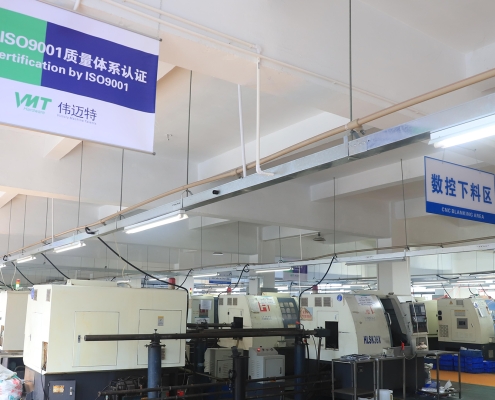
In Conclusion
Understanding the types of pins is crucial for precision and efficiency in engineering. From fasteners pins to different pin types, each plays a unique role. Partner with VMT for custom solutions that guarantee exceptional quality.
Frequently Asked Questions About Pin
How to Drop a Pin?
Dropping a pin typically refers to marking a location on a digital map. Open the map application on your device, press and hold the desired location until a pin appears. You can save, share, or navigate to the marked spot. This is useful for pinpointing exact places like meeting points or landmarks.
What are the Classifications of Pins?
-
Pins can be classified based on their purpose and design. Common categories include:
-
Fastening Pins: Such as safety pins, cotter pins, and clevis pins.
-
Locating Pins: Used in machinery to position components.
-
Decorative Pins: Like lapel pins or brooches for aesthetics.
-
Electronic Pins: Found in connectors and circuits for electrical connections.
What are Pins in Engineering?
In engineering, pins are mechanical fasteners or positioning components used to align, join, or secure parts. Common types include dowel pins for precise alignment, taper pins for securing, and split pins for locking. Pins ensure stability and accurate assembly in various applications, from machinery to structural components.
What are the Types of Safety Pins?
Safety pins come in several types, including:
-
Standard Safety Pins: Simple and widely used for fastening fabric or temporary repairs.
-
Curved Safety Pins: Designed for quilting and sewing to ease fabric penetration.
-
Coilless Safety Pins: Without a coil, ideal for delicate materials.
-
Heavy-Duty Safety Pins: Larger and stronger, used for securing heavy materials or industrial applications.
What Tools Are Needed for Pin Fasteners?
The tools required for pin fasteners depend on the type of pin and the job. For simple tasks, basic tools like hammers and pliers are often enough. Hammers are commonly used to tap dowel or taper pins into place, while pliers help remove cotter or safety pins. For more precise or heavy-duty pins, you might need tools like punches, alignment pins, or socket wrenches.
How Do Pin Fasteners Work?
Pin fasteners work by holding parts together through pressure, fit, or locking features. Some pins, like dowel and taper pins, use tight holes to create a friction fit. Others, like spring pins, expand inside a hole to stay firmly in place. Pins such as clevis or cotter pins use holes and clips to secure moving parts, while lock pins use push-button or detent mechanisms for easy removal.



